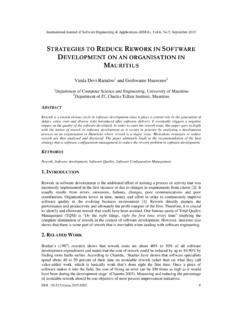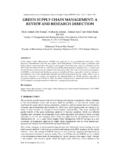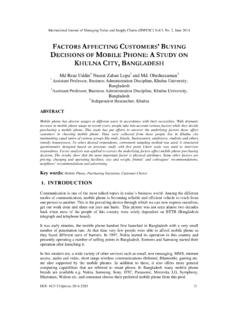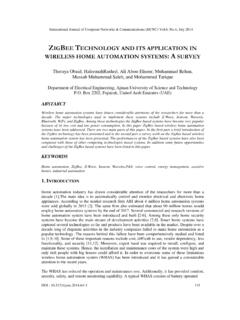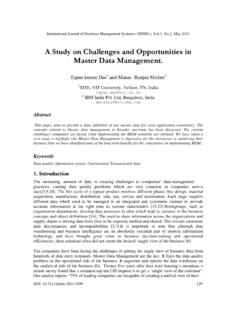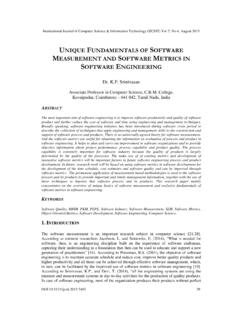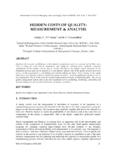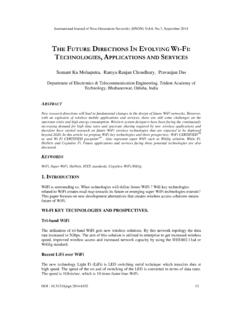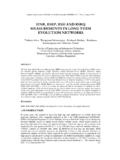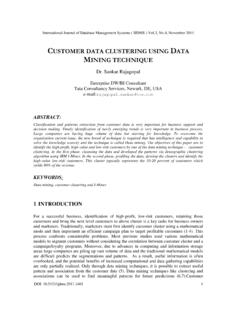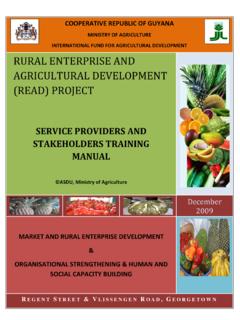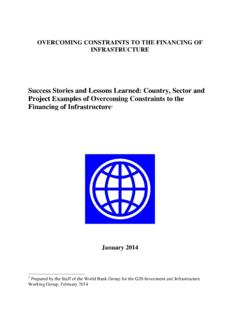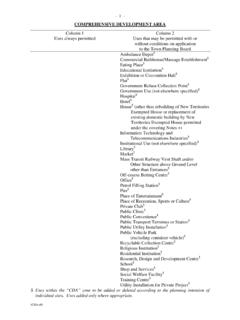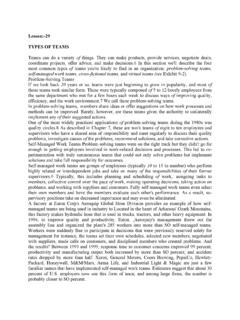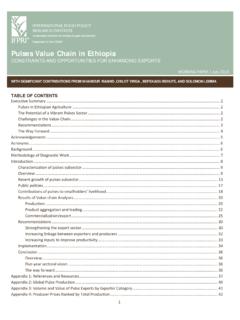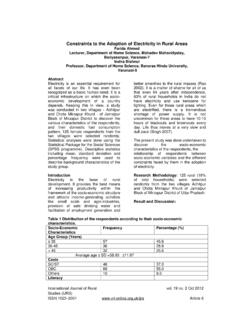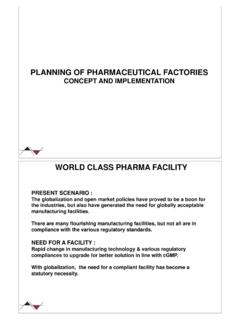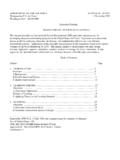Transcription of REQUIREMENT ANALYSIS METHOD OF E- …
1 International Journal of Software Engineering & Applications (IJSEA), , , March 2014. REQUIREMENT ANALYSIS METHOD OF E- COMMERCE WEBSITES development FOR SMALL- MEDIUM ENTERPRISES, CASE STUDY: INDONESIA. Veronica S. Moertini1, Suhok2, Silvania Heriyanto3 and Criswanto D. Nugroho4. Informatics Department, Parahyangan Catholic University, Indonesia ABSTRACT. Along with the growth of the Internet, the trend shows that e-commerce have been growing significantly in the last several years. This means business opportunities for small-medium enterprises (SMEs), which are recognized as the backbone of the economy. SMEs may develop and run small to medium size of particular e-commerce websites as the solution of specific business opportunities. Certainly, the websites should be developed accordingly to support business success. In developing the websites, key elements of e-commerce business model that are necessary to ensure the success should be resolved at the REQUIREMENT stage of the development .
2 In this paper, we propose an enhancement of REQUIREMENT ANALYSIS METHOD found in literatures such that it includes activities to resolve the key elements. The METHOD has been applied in three case studies based on Indonesia situations and we conclude that it is suitable to be adopted by SMEs. KEYWORDS. Software requirements ANALYSIS , E-Commerce Website development , Resolving Key Elements of E- Commerce Business Model 1. INTRODUCTION. It is well recognized that small-medium enterprises (SMEs) are significant to the worldwide socio-economic development . It is even viewed that SMEs are the backbone of the economy. SMEs have also contributed significantly in higher growth of employment, output, promotion of exports, and fostering entrepreneurship [5, 7]. In Indonesia, SMEs have been growing such that they contribute to 56 percent of GDP and absorb around 97 percent of the manpower [22].
3 Along with the growth of the Internet, it is noted that since e-commerce was born in 1995 both the B2C (business to consumer) and B2B (business to business) e-commerce have been growing exponentially [8]. The proliferation happens not only in the developed countries, but also in developing countries. The B2C sale in Asia-Pacific region in 2011 was of world-wide sales, and is predicted to grow up to by 2016. In China, e-commerce has grown by 120%. per year since 2003. It is also predicted that e-commerce in China, India and Indonesia will grow the fastest in 2013 [7]. The growth of e-commerce means business opportunities for SMEs. SMEs may develop and operate small to medium size of B2B, B2C or C2C (consumer to consumer) e-commerce systems. SMEs may start up new e-commerce business. Those who already run off-line business can go online to access new markets and overcome distances.
4 As going online require management changes, the SMEs have the advantage of implementing strategic and organizational changes DOI : 11. International Journal of Software Engineering & Applications (IJSEA), , , March 2014. much more quickly and at lower cost than large companies [16]. In Indonesia, the SMEs opportunities to set up e-commerce systems are backed up by this fact: In the last several years the Internet users have been increasing exponentially. While the number of users in 2012 was 55. million [20], in 2013 it has reached 60-70 million and it is predicted that in 2015 it will be 100. million [24]. As a type of computer-based information system, e-commerce systems include people, procedures, computer networks, software and database. This research focuses on the software component, which is website. There are several approaches of software development , such as water-fall, prototyping, spiral, agile, and so on [2].
5 Each of these will basically include stages of REQUIREMENT , system ANALYSIS , design, implementation, testing, deployment and maintenance. Among these stages, it is recognized that REQUIREMENT is a complex and risky task [13; 4] such that broad spectrum of tasks and techniques that lead to an understanding of requirements , which is called requirements engineering, have been developed [18]. In the context of SMEs who will set up new e-commerce businesses, the required websites that will be developed should significantly support their success. We find that the eight key elements of e-commerce business model defined in [8] as the success keys must be resolved at the REQUIREMENT stage. Unfortunately, we have not found research results that specifically include these elements in analyzing requirements of e-commerce websites. Hence, we intend to contribute in designing a REQUIREMENT ANALYSIS METHOD that resolves these key elements.
6 After studying some literatures, we find that [18] has discussed broad methods of analyzing requirements . We enhance the early activities formulated in [18] such that the key elements are resolved accordingly. Research methods : We first study literatures related to software development , REQUIREMENT , and e- commerce website development . We then design the proposed enhanced REQUIREMENT ANALYSIS METHOD , apply the METHOD to three case studies based on Indonesia environment (the requirements resulting from the applying the METHOD are then used in developing website prototypes), and evaluate the METHOD . This paper is organized as the following: Introduction, literature study (software REQUIREMENT , development of e-commerce website and key elements of e-commerce business model), proposed methods , case studies, METHOD evaluation, and conclusion.
7 In the appendix we include detailed results of two case studies. 2. LITERATURE STUDY. Software REQUIREMENT REQUIREMENT engineering and ANALYSIS : Brief discussion of software REQUIREMENT engineering and ANALYSIS that are related to the proposed METHOD are as follows [13]: The broad spectrum of tasks and techniques that lead to an understanding of requirements is called requirements engineering. requirements engineering, which is a major process in software engineering, provides the appropriate mechanism for understanding what the customer wants, analyzing need, assessing feasibility, specifying the solution unambiguously, and so on. It encompasses seven distinct tasks, which are inception, elicitation, elaboration, negotiation, specification, validation, and management. Some of these tasks occur in parallel and all are adapted to the needs of the project.
8 At project inception, among other things, system analysts establish a basic understanding of the problem, the people who want a solution and the nature of the solution that is desired. The activity includes establishing product vision and project scope [18]. At the REQUIREMENT elicitations, activities are performed to formulate the objectives for the system, what is to be 12. International Journal of Software Engineering & Applications (IJSEA), , , March 2014. accomplished, how the system or product fits into the needs of the business, and how the system is to be used. requirements elicitation (also called requirements gathering) combines elements of problem solving, elaboration, negotiation, and specification. requirements ANALYSIS is the activity of elaborating basic requirements established during the inception, elicitation and negotiation tasks.
9 requirements ANALYSIS results in the software specification detailing the operational characteristics, interface with other system elements, and constraints that the software must meet. requirements : Based on their functions, requirements can be classified into: (a) Functional requirements , which describe system functionalities or services; (b) Non-functional requirements , which define system properties and constraints ( reliability, response time and storage requirements ). The functional and non-functional requirements can further be classified into few types and have relationship as shown in Figure 1 [18]. As this research mainly concerns with business requirements that will be used in designing user requirements and the business rules that will be included in the use-case document, brief descriptions are provided for the three as follows: (a) Business requirements : Represent high-level objectives of the organization or customer who requests the system.
10 They describe why the organization is implementing the system (the objectives the organization hopes to achieve). (b) User requirements : Describe user goals or tasks that the users must be able to perform with the product. (c) Business rules: The rules in the organization that affect the system, which include corporate policies, government regulations, industry standards, accounting practices, and computational algorithms. Figure 1. Relationship of requirements [18]. As depicted in Figure 1, the vision and scope document collects the business requirements into a single document that sets the stage for the subsequent development work. It typically contains: (a) Business requirements , which includes background, business opportunity, business objectives and success criteria, customer or market needs and business risks;. (b) Vision of the solution, which includes vision statement, major features, assumptions and dependencies.
